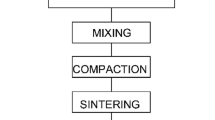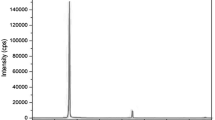Abstract
This paper presents the investigation of tribological behaviour of aluminium hybrid composites with Al–Si alloy A356 matrix, reinforced with 10 wt% silicon carbide and 0, 1 and 3 wt% graphite (Gr) with the application of Taguchi’s method. Tribological investigations were realized on block-on-disc tribometer under lubricated sliding conditions, at three sliding speeds (0.25, 0.5 and 1 m/s), three normal loads (40, 80 and 120 N) and at sliding distance of 2400 m. Wear rate and coefficient of friction were measured within the research. Analysis of the results was conducted using ANOVA technique, and it showed that the smallest values of wear and friction are observed for hybrid composite containing 3 wt% Gr. The prediction of wear rate and coefficient of friction was performed with the use of artificial neural network (ANN). After training of the ANN, the regression coefficient was obtained and it was equal to 0.98905 for the network with architecture 3-20-30-2.










Similar content being viewed by others
References
Vencl A (2012) Tribology of the Al–Si alloy based MMCs and their application in automotive industry. In: Magagnin L (ed) Engineered metal matrix composites: forming methods, material properties and industrial applications. Nova Science Publishers, New York, pp 127–166
Stojanović BŽ, Milojević ST (2017) Characterization, manufacturing and application of metal matrix composites. In: Wythers MC (ed) Advances in materials science research, vol 30. Nova Science Publishers, New York, pp 83–113
Stojanovic B, Glisovic J (2016) Automotive engine materials. In: Hashmi S (ed) Reference module in materials science and materials engineering. Elsevier, Oxford, pp 1–9
Bodunrin MO, Alaneme KK, Chown LH (2015) Aluminium matrix hybrid composites: a review of reinforcement philosophies; mechanical, corrosion and tribological characteristics. J Mater Res Technol 4(4):434–445
Stojanovic B, Babic M, Mitrovic S, Vencl A, Miloradovic N, Pantic M (2013) Tribological characteristics of aluminium hybrid composites reinforced with silicon carbide and graphite. A review. J Balkan Tribol Assoc 19(1):83–96
Stojanovic B, Blagojević J, Babic M, Veličković S, Miladinovic S (2017) Optimization of hybrid aluminum composites wear using Taguchi method and artificial neural network. Ind Lubr Tribol 69(6):1005–1015
Stojanović B, Veličković S, Vencl A, Babić M, Petrović N, Miladinović S, Cherkezova-Zheleva Z (2016) Optimization and prediction of aluminium composite wear using Taguchi design and artificial neural network. Tribol J BULTRIB 6:38–45
Suresha S, Sridhara BK (2010) Effect of addition of graphite particulates on the wear behaviour in aluminium-silicon carbide-graphite composites. Mater Des 31(4):1804–1812
Suresha S, Sridhara BK (2010) Effect of silicon carbide particulates on wear resistance of graphitic aluminium matrix composites. Mater Des 31(9):4470–4477
Suresha S, Sridhara BK (2012) Friction characteristics of aluminium silicon carbide graphite hybrid composites. Mater Des 34:576–583
Radhika N, Subramaniam R (2013) Wear behaviour of aluminium/alumina/graphite hybrid metal matrix composites using Taguchi’s techniques. Ind Lubr Tribol 65(3):166–174
Taşdelen ME, Dağaşan E, Gerçekcioğlu E (2016) Prediction of tribological behavior of TiN coated hot work steel at high temperatures using artificial neural network. J Balkan Tribol Assoc 22(2A-I):1808–1820
Hassan AKF, Mohammed S (2016) Artificial neural network model for estimation of wear and temperature in pin-disc contact. Univers J Mech Eng 4(2):39–49
Vencl A, Bobić I, Jovanović MT, Babić M, Mitrović S (2008) Microstructural and tribological properties of A356 Al–Si alloy reinforced with Al2O3 particles. Tribol Lett 32(3):159–170
Roy KR (1990) A primer on the Taguchi method. Van Nostrand Reinhold, New York
Basavarajappa S, Chandramohan G, Davim JP (2007) Application of Taguchi techniques to study dry sliding wear behaviour of metal matrix composites. Mater Des 28(4):1393–1398
Taguchi G (1993) Taguchi on robust technology development: bringing quality engineering upstream. ASME Press, New York
Sahin Y (2005) The prediction of wear resistance model for the metal matrix composites. Wear 258(11–12):1717–1722
Montgomery DC (2007) Design and analysis of experiments. Wiley, New Delhi
Veličković S, Stojanović B, Babić M, Bobić I (2017) Optimization of tribological properties of aluminum hybrid composites using Taguchi design. J Compos Mater 51(17):2505–2515
Miljković Z, Mitić M, Lazarević M, Babić B (2013) Neural network reinforcement learning for visual control of robot manipulators. Expert Syst Appl 40(5):1721–1736
Vuković N, Miljković Z (2013) A growing and pruning sequential learning algorithm of hyper basis function neural network for function approximation. Neural Netw 46:210–226
Li XY, Tandon KN (2000) Microstructural characterization of mechanically mixed layer and wear debris in sliding wear of an Al alloy and an Al based composite. Wear 245(1–2):148–161
Harichandran R, Selvakumar N (2016) Effect of nano/micro B4C particles on the mechanical properties of aluminium metal matrix composites fabricated by ultrasonic cavitation-assisted solidification process. Arch Civ Mech Eng 16(1):147–158
Acknowledgement
This work has been performed as a part of activities within the projects TR 35021 and TR 34028. These projects are supported by the Republic of Serbia, Ministry of Education, Science and Technological Development, whose financial help is gratefully acknowledged. Collaboration through the bilateral project No. 451-03-02294/2015-09/9 between Republic of Serbia and Hungary is also acknowledged.
Author information
Authors and Affiliations
Corresponding author
Ethics declarations
Conflict of interest
The authors declare that they have no conflict of interest.
Additional information
Technical Editor: Marcelo A. Trindade.
Rights and permissions
About this article
Cite this article
Stojanović, B., Vencl, A., Bobić, I. et al. Experimental optimisation of the tribological behaviour of Al/SiC/Gr hybrid composites based on Taguchi’s method and artificial neural network. J Braz. Soc. Mech. Sci. Eng. 40, 311 (2018). https://doi.org/10.1007/s40430-018-1237-y
Received:
Accepted:
Published:
DOI: https://doi.org/10.1007/s40430-018-1237-y




